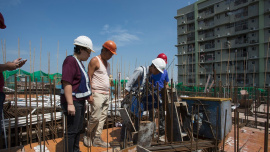For those of you still labouring under the efficient markets hypothesis here is a tidbit: investors overestimate the chances of a stock market crash by a factor of about 10. Thats the upshot of a new analysis of data collected by Nobel Prize winner Robert Shiller over decades showing that individual investors, and to a lesser extent institutional ones, wildly overrate the chances of a 1929- or 1987-style crash. Investors as a whole during the period 1989-2015 assigned a median probability of 10 percent of a crash in the U.S. over the next six months, according to the study (Follow QR code below to reach the paper). The mean, amazingly, was 19 percent. Of course these are the same individual investors whose expectations of a crash grow if an earthquake happens near where they live. It seems a wonder there isnt panic selling every time there is a solar eclipse. Individual investors in 2015 put the chances of a crash in the next six months at about 20 percent, with institutional investors coming in slightly below that. We find evidence that investors use recent market performance to estimate probabilities about a crash, Shiller, his Yale colleague William Goetzmann and Dasol Kim of Case Western Reserve University write in a working paper. We also find that the press makes negative market returns relatively more salient and this is associated with individual investor probability assessments of a crash. Looking at the entire history of daily movements in the Dow Jones Industrial Average and assuming a coin-flip-like distribution of returns, the authors estimate that the actual chance of a crash over a six-month period is about 1 percent. The study looked at a survey Shiller has been carrying out which quizzes individual and institutional investors about a variety of topics, including asking them to assign a probability to the chances of a 1929- or 1987-type crash over the coming six months. One thing is clear, investors read about what is happening and are influenced by recent events. As you might expect, investor expectations of a coming crash shifted higher in 2008 and have remained stubbornly high, even as the VIX volatility index, which is sometimes used as a shorthand for risk, has trended lower. Events in 2008 and 2009 were both massively covered and highly memorable, and possibly have had a lasting impact on expectations. The volcano god is angry Less clear is what all of this means for investor behaviour. Certainly the U.S. stock market has not traded as if the people who own it think it quite likely that we will soon have a crash. My supposition, and this is far outside the bounds of the study, is that official support of financial markets, by governments and central banks, has forced professional, benchmarked investors to track asset values higher while still leaving many worried about the fundamentals. It is also quite true that it is impossible to actually calculate the chances of a crash, past distribution being no certain guide to future outcomes. Another purpose of the study was to look at the relationship between how the media covers financial events and how investors view the likelihood of a crash. Interestingly, individual investor responses to the survey are significantly associated with negative media coverage of the financial markets during downturns, but not with positive coverage during booms. Institutional investors, as you would hope, are not influenced in this way by the media. To test whether investors are irrationally influenced by unrelated events to read across higher chances of a crash in financial markets, the study looked at the responses of investors who lived within 30 miles of a moderate earthquake, one which was big enough to be upsetting but not an economic force which would drive the overall stock market. These quakes, of up to 5.5 magnitude, do have a positive association with investor crash probabilities, but only for individuals. In other words, one bad thing happening makes people think something else bad might happen, even if there is no possible relationship. This is an example of the availability heuristic, or bias, the tendency described by Amos Tversky and Daniel Kahneman of people to use easily remembered information to make complex judgements. To be sure, individual investors could turn out to be right and crashes may have simply been happening less often than they should. Still, the easiest lesson may be: dont be an individual investor, but do play poker with them if you get the chance. Then bluff, especially after they suffer a bad beat.
Top Stories
RELATED ARTICLESMORE FROM AUTHOR
OPINION – Investing in Diversification!
As the lights of the Great Hall of the People in Beijing, where the “Two...
【時事評論】公共工程需考慮長遠經濟社會效益
在經濟衰退的時候,著名經濟學家凱恩斯就會被搬出來,為政府加大投資,大興土木的建設基礎設施以推動經濟發展背書。此一說法被詬病多時,然而不少政府及政治人物卻情有獨鍾,甚至樂此不疲。内地奉行鋼筋水泥經濟多時,這股基建風南下到港澳,澳門近年的基建或者大大小小的各項公共工程無日無之,這些能否推動澳門經濟高質發展?事實唔使問阿貴,作用並不顯著。
OPINION – Forum Macau’s 6th Ministerial Conference: Will there be some good news for...
By José Luís de Sales Marques
The highly anticipated Forum...























